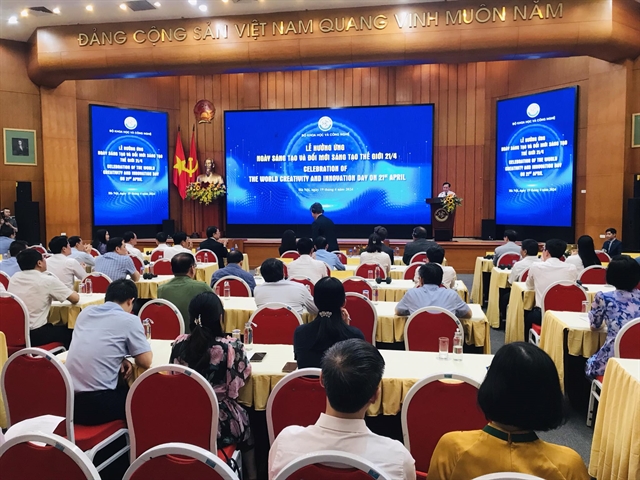 Society
Society


|
| Experts attend the conference. — VNS Photo Thu Trang |
HÀ NỘI — Việt Nam’s national innovation system has been increasingly completed during the past years, said Minister of Science and Technology Huỳnh Thành Đạt in a conference held in Hà Nội on Friday.
The conference was organised by the Ministry of Science and Technology as part of the World Creativity and Innovation Day 2024, which will fall on Sunday.
The day was chosen by the United Nations (UN) General Assembly in 2017.
The event was organised to raise awareness about the role of creativity and innovation in socio-economic growth, building a sustainable society and promoting all aspects of human development.
It also targeted to call for organisations and individuals to work together in speeding up innovation activities.
The event hoped to strengthen national innovation system development with close connection between State agencies, manufacturers, enterprises and investors.
Speaking at the conference, Đạt emphasised that Việt Nam reached achievements in the field thanks to joint efforts of ministries, localities, enterprises and scientists, and support from international organisations.
The Global Innovation Index (GII) has been announced annually by the World Intellectual Property Organisation since 2017 and has been used by the Việt Nam Government as an important tool to compile and promulgate policies to promote innovation.
Since then, Việt Nam's GII ranking has continuously improved, increased from position 59 in 2016 to position 46 last year.
“Việt Nam always maintains the second position in the group of low middle-income countries and is one of seven middle-income countries that have made the most progress in innovation over the past decade,” said Đạt.
Since last year, with technical support from the World Intellectual Property Organisation, the Provincial Innovation Index (PII) has officially been deployed nationwide.
The implementation follows the Government’s instruction in Resolution 10/NQ-CP issued on February 3.
The PII aims to provide an overall view of current socio-economic development based on science, technology and innovation of each locality.
Thereby, it provides basis and evidence on strengths, weaknesses, potential factors and necessary conditions to enhance socio-economic growth based on science, technology and innovation for every province and city.
Besides achieved results, Đạt said, Việt Nam's innovation capacity needed to be improved more strongly in the coming period to increase labour productivity and product quality, environmental protection and sustainable development.
“Việt Nam is transforming its growth model from relying on capital and labour to one based on science, technology and innovation. This is a long-term goal, requiring the participation and joint contributions of the entire society,” he said.
Đạt wished to receive more guidance from the Party, Government and National Assembly; support and cooperation of ministries, localities, research institutes, universities and businesses so that scientific research, technological development and innovation activities can make more and more practical contributions to the nation.
Pauline Tamesis, UN Resident Coordinator in Việt Nam, said that innovation had the potential to advance achievement toward Sustainable Development Goals (SDGs) and the UN’s 2030 Agenda.
According to the national volunteer report on SDGs last year, Việt Nam has achieved five out of 17 SDGs.
In the coming years, she recommended Việt Nam to intensify the process of achieving these goals through innovation and creativity.
The country should inspire green technology and solutions to respond to new challenges, reduce carbon emissions, as well as enhance environmental sustainability, improve people's lives and bring economic opportunities.
Pauline Tamesis assessed that Việt Nam could achieve its vision of becoming a high-income developed country by 2045.
Innovation is not limited to high-tech fields with scientists, but needs to include innovators at the grassroots level, especially youth.
Aspirations for Việt Nam to become a high-income developed country by 2045 depend on creating good conditions for creativity and innovation, she said.
During the conference, scientists and experts discussed an overview of innovation in enterprises; policies and orientations to push the national creative startup ecosystem; innovation measurement tools; and creative startups. — VNS




